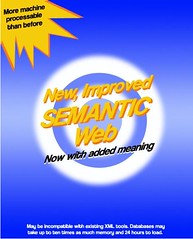 Bent Rasmussen started a terrific discussion on Twine today regarding an article titled “Never Mind the Semantic Web.” After reading Bent’s comment and the article, I started thinking again about adding “semantic” markup in (X)HTML. My comment follows:
Bent Rasmussen started a terrific discussion on Twine today regarding an article titled “Never Mind the Semantic Web.” After reading Bent’s comment and the article, I started thinking again about adding “semantic” markup in (X)HTML. My comment follows:
I read your comment before reading the article, and I originally agreed with your comment. Then I read the article, and I can’t help agreeing with almost every point. Almost. At the same time, I still agree with your comment. I know that probably sounds ridiculous, but it’s true. Everything you said is spot on target. Maybe explaining my thoughts, having read both, would help.
After reading the article, I can’t help thinking that RDF really doesn’t belong within (X)HTML. This is a pretty big deal for me, but I can’t get away from it. From a truly semantic pov, (X)HTML describes a document. I realize that it has been exploded to do all sorts of amazing things, but it is, at it’s roots, a document format. Why force even more into an almost back-broken format? (X)HTML’s own tags can provide a load of semantic information about the document, and that’s really all it should provide.
Microformats are a great way of recognizing that and staying fairly consistent to that nature, but they really aren’t a very good solution. Creating RDF using n3 is much easier than XML, though both are fine, and are much easier to create independent of (X)HTML. Building a tool to create RDF data to store at a specific URI would allow so much more data to be placed out on the SemWeb much faster. Then, using the
relandrevattributes already in (X)HTML, you could extract triples to relate web pages (HTML) to web resources (RDF, etc.) and complete the graph without trying to force in so much more information than necessary into (X)HTML.Maybe I’m a bit naive, but that seems like a really workable solution. And if you must find a way to represent all RDF as a (X)HTML, XSLT and XQuery are great tools for doing just that, keeping in mind you are now creating a document to display data for the resource. Standard templates/queries should be able to go a long way–sort of a reverse GRDDL approach.
Or am I just missing something huge and obvious? (I tend to do that sometimes.)
If you read my previous post on the Future of Web Applications, you may think I already thought this. Well, I wish I had, but at the time I hadn’t quite reached this point. After all, I thought embedding resources within (X)HTML would make everything more maintainable. However, maintaining data on a person, event, etc. is much more easily done in one place and then linked by others. Why embed something that may already exist elsewhere? And why make your web page, which may only haphazardly relate to the embedded content, the responsible source for maintaining that embedded item?
Rather, I’d love to see tools like WordPress and others provide tools for creating and managing this content locally or link to resources elsewhere, such as in your Google Calendar.



















